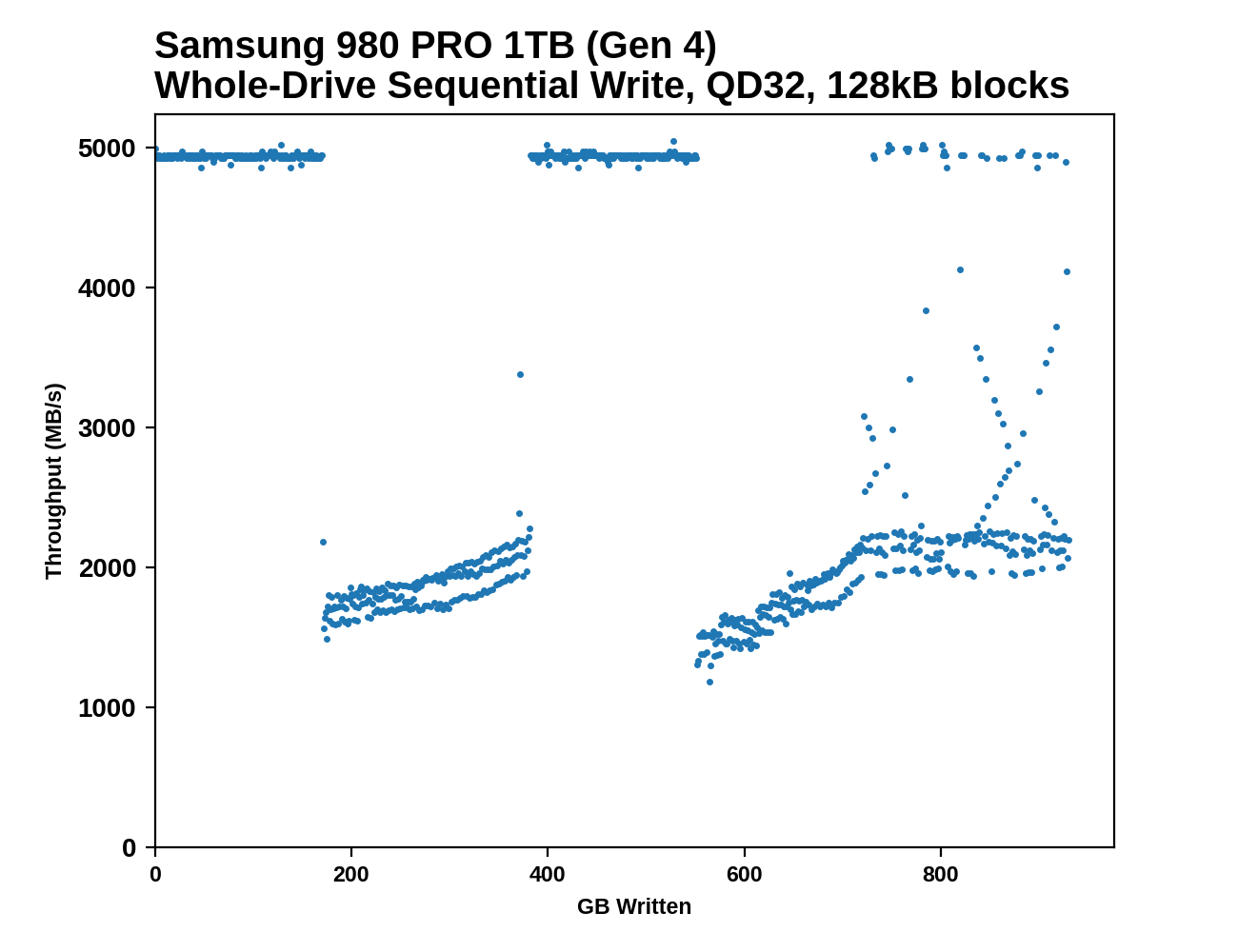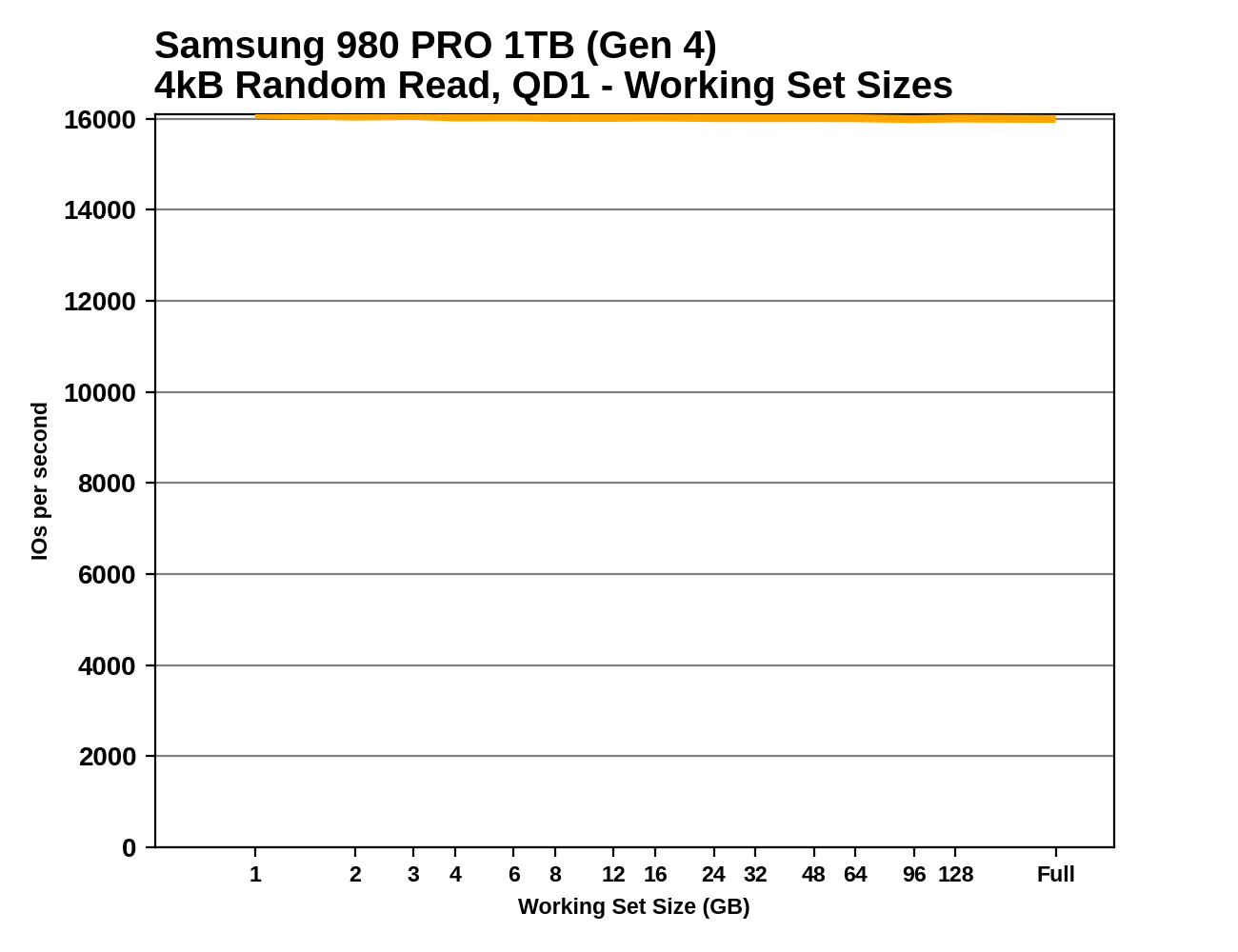The Samsung 980 PRO PCIe 4.0 SSD Review: A Spirit of Hope
by Billy Tallis on September 22, 2020 11:20 AM ESTWhole-Drive Fill
This test starts with a freshly-erased drive and fills it with 128kB sequential writes at queue depth 32, recording the write speed for each 1GB segment. This test is not representative of any ordinary client/consumer usage pattern, but it does allow us to observe transitions in the drive's behavior as it fills up. This can allow us to estimate the size of any SLC write cache, and get a sense for how much performance remains on the rare occasions where real-world usage keeps writing data after filling the cache.
 |
|||||||||
Both tested capacities of the 980 PRO perform more or less as advertised at the start of the test: 5GB/s writing to the SLC cache on the 1TB model and 2.6GB/s writing to the cache on the 250GB model - the 1 TB model only hits 3.3 GB/s when in PCIe 3.0 mode. Surprisingly, the apparent size of the SLC caches is larger than advertised, and larger when testing on PCIe 4 than on PCIe 3: the 1TB model's cache (rated for 114GB) lasts about 170GB @ Gen4 speeeds and about 128GB @ Gen3 speeds, and the 250GB model's cache (rated for 49GB) lasts for about 60GB on Gen4 and about 49GB on Gen3. If anything it seems that these SLC cache areas are quoted more for PCIe 3.0 than PCIe 4.0 - under PCIe 4.0 however, there might be a chance to free up some of the SLC as the drive writes to other SLC, hence the increase.
An extra twist for the 1TB model is that partway through the drive fill process, performance returns to SLC speeds and stays there just as long as it did initially: another 170GB written at 5GB/s (124GB written at 3.3GB/s on Gen3). Looking back at the 970 EVO Plus and 970 EVO we can see similar behavior, but it's impressive Samsung was able to continue this with the 980 PRO while providing much larger SLC caches—in total, over a third of the drive fill process ran at the 5GB/s SLC speed, and performance in the TLC writing phases was still good in spite of the background work to flush the SLC cache.
 |
|||||||||
| Average Throughput for last 16 GB | Overall Average Throughput | ||||||||
On the Gen4 testbed, the overall average throughput of filling the 1TB 980 PRO is only slightly slower than filling the MLC-based 970 PRO, and far faster than the other 1TB TLC drives. Even when limited by PCIe Gen3, the 980 Pro's throughput remains in the lead. The smaller 250GB model doesn't make good use of PCIe Gen4 bandwidth during this sequential write test, but it is a clear improvement over the same capacity of the 970 EVO Plus.
Working Set Size
Most mainstream SSDs have enough DRAM to store the entire mapping table that translates logical block addresses into physical flash memory addresses. DRAMless drives only have small buffers to cache a portion of this mapping information. Some NVMe SSDs support the Host Memory Buffer feature and can borrow a piece of the host system's DRAM for this cache rather needing lots of on-controller memory.
When accessing a logical block whose mapping is not cached, the drive needs to read the mapping from the full table stored on the flash memory before it can read the user data stored at that logical block. This adds extra latency to read operations and in the worst case may double random read latency.
We can see the effects of the size of any mapping buffer by performing random reads from different sized portions of the drive. When performing random reads from a small slice of the drive, we expect the mappings to all fit in the cache, and when performing random reads from the entire drive, we expect mostly cache misses.
When performing this test on mainstream drives with a full-sized DRAM cache, we expect performance to be generally constant regardless of the working set size, or for performance to drop only slightly as the working set size increases.
 |
|||||||||
Since these are all high-end drives, we don't see any of the read performance drop-off we expect from SSDs with limited or no DRAM buffers. The two drives using Silicon Motion controllers show a little bit of variation depending on the working set size, but ultimately are just as fast when performing random reads across the whole drive as they are reading from a narrow range. The read latency measured here for the 980 PRO is an improvement of about 15% over the 970 EVO Plus, but is not as fast as the MLC-based 970 PRO.










137 Comments
View All Comments
XabanakFanatik - Wednesday, September 23, 2020 - link
You, sir, are not the target market for a PRO series drive.Railgun - Tuesday, September 22, 2020 - link
While the article is painfully incomplete, its 3.0 performance is a bit of a moot point. I’m particularly waiting for the 4.0 test results as that’s what will count here.WaltC - Tuesday, September 22, 2020 - link
MBs per watt...not very useful for performance scenarios, imo. I agree this is not one of AT's shining moments...;)Notmyusualid - Tuesday, October 6, 2020 - link
@ Railgun - it is valid testing for those of us whos m/b's only support PCIe3...Ashantus - Tuesday, September 22, 2020 - link
Hell anandtech,i am badly missing the comparison to the modern M2- PCI 4.0 SSD with Toshiba Nanad and Phison E-16 controller. So either the Corsair MP600 or the Gigabyte Aorus. Other websites did the comparison in their Test, and Samsung hit the floor.
Are you trying to protect Samsung by avoiding the big competitors?
Makaveli - Tuesday, September 22, 2020 - link
Reading comprehension is important."Any Phison E16 Drive at PCIe 4.0, such as Seagate FireCuda 520"
This drive is in the review!
Luckz - Thursday, September 24, 2020 - link
There's even (at least) two of these reading allergy guys in the comments here.ppi - Tuesday, September 22, 2020 - link
"Hype for the upcoming generation of game consoles has suggested that future video games may reach the point of needing the equivalent of an entire CPU core to manage IO, but that's only after using the equivalent of several more cores to decompress data and feed it to a powerful GPU running the kind of game engine that doesn't exist yet. Our new benchmark suite will be designed with such workloads in mind, but current consumer workloads aren't there yet and won't be for at least a few years."Major developers have had access to new consoles for some time already. I would not be surprised to see it used next year in some technologically ambitious game, or even in Cyberpunk 2077.
Slash3 - Tuesday, September 22, 2020 - link
On the PC side, it's basically predicated on Microsoft incorporating final Directstorage API support into a Windows update, which likely won't happen until the middle of next year.PopinFRESH007 - Tuesday, September 22, 2020 - link
Likely not untrue, but it isn't solely in the hands of Microsoft. Developers will still be able to leverage RTXIO, however, as we've seen with many other NVIDIA technologies there are a few games that will take advantage and the bulk will stick to less proprietary technologies. As such I think we will likely only see RTXIO leveraged via DirectStorage for games that are developed cross platform for Xbox Series X|S and Windows 10 PC.